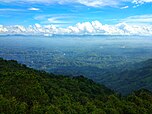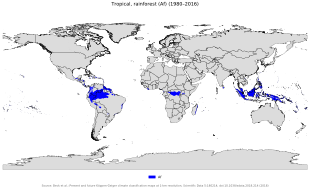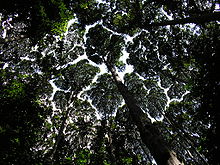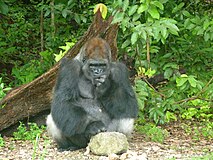Lagrangian field theory is a formalism in classical field theory. It is the field-theoretic analogue of Lagrangian mechanics. Lagrangian mechanics is used to analyze the motion of a system of discrete particles each with a finite number of degrees of freedom. Lagrangian field theory applies to continua and fields, which have an infinite number of degrees of freedom.
One motivation for the development of the Lagrangian formalism on fields, and more generally, for classical field theory, is to provide a clean mathematical foundation for quantum field theory, which is infamously beset by formal difficulties that make it unacceptable as a mathematical theory. The Lagrangians presented here are identical to their quantum equivalents, but, in treating the fields as classical fields, instead of being quantized, one can provide definitions and obtain solutions with properties compatible with the conventional formal approach to the mathematics of partial differential equations. This enables the formulation of solutions on spaces with well-characterized properties, such as Sobolev spaces. It enables various theorems to be provided, ranging from proofs of existence to the uniform convergence of formal series to the general settings of potential theory. In addition, insight and clarity is obtained by generalizations to Riemannian manifolds and fiber bundles, allowing the geometric structure to be clearly discerned and disentangled from the corresponding equations of motion. A clearer view of the geometric structure has in turn allowed highly abstract theorems from geometry to be used to gain insight, ranging from the Chern–Gauss–Bonnet theorem and the Riemann–Roch theorem to the Atiyah–Singer index theorem and Chern–Simons theory.
Overview
In field theory, the independent variable is replaced by an event in spacetime (x, y, z, t), or more generally still by a point s on a Riemannian manifold. The dependent variables are replaced by the value of a field at that point in spacetime so that the equations of motion are obtained by means of an action principle, written as:
where the brackets denote ; and s = {sα} denotes the set of n independent variables of the system, including the time variable, and is indexed by α = 1, 2, 3, ..., n. The calligraphic typeface, , is used to denote the density, and is the volume form of the field function, i.e., the measure of the domain of the field function.
In mathematical formulations, it is common to express the Lagrangian as a function on a fiber bundle, wherein the Euler–Lagrange equations can be interpreted as specifying the geodesics on the fiber bundle. Abraham and Marsden's textbook provided the first comprehensive description of classical mechanics in terms of modern geometrical ideas, i.e., in terms of tangent manifolds, symplectic manifolds and contact geometry. Bleecker's textbook provided a comprehensive presentation of field theories in physics in terms of gauge invariant fiber bundles. Such formulations were known or suspected long before. Jost continues with a geometric presentation, clarifying the relation between Hamiltonian and Lagrangian forms, describing spin manifolds from first principles, etc. Current research focuses on non-rigid affine structures, (sometimes called "quantum structures") wherein one replaces occurrences of vector spaces by tensor algebras. This research is motivated by the breakthrough understanding of quantum groups as affine Lie algebras (Lie groups are, in a sense "rigid", as they are determined by their Lie algebra. When reformulated on a tensor algebra, they become "floppy", having infinite degrees of freedom; see e.g. Virasoro algebra.)
Definitions
In Lagrangian field theory, the Lagrangian as a function of generalized coordinates is replaced by a Lagrangian density, a function of the fields in the system and their derivatives, and possibly the space and time coordinates themselves. In field theory, the independent variable t is replaced by an event in spacetime (x, y, z, t) or still more generally by a point s on a manifold.
Often, a "Lagrangian density" is simply referred to as a "Lagrangian".
Scalar fields
For one scalar field , the Lagrangian density will take the form:
For many scalar fields
In mathematical formulations, the scalar fields are understood to be coordinates on a fiber bundle, and the derivatives of the field are understood to be sections of the jet bundle.
Vector fields, tensor fields, spinor fields
The above can be generalized for vector fields, tensor fields, and spinor fields. In physics, fermions are described by spinor fields. Bosons are described by tensor fields, which include scalar and vector fields as special cases.
For example, if there are real-valued scalar fields, , then the field manifold is . If the field is a real vector field, then the field manifold is isomorphic to .
Action
The time integral of the Lagrangian is called the action denoted by S. In field theory, a distinction is occasionally made between the Lagrangian L, of which the time integral is the action
The spatial volume integral of the Lagrangian density is the Lagrangian; in 3D,
The action is often referred to as the "action functional", in that it is a function of the fields (and their derivatives).
Volume form
In the presence of gravity or when using general curvilinear coordinates, the Lagrangian density will include a factor of . This ensures that the action is invariant under general coordinate transformations. In mathematical literature, spacetime is taken to be a Riemannian manifold and the integral then becomes the volume form
Here, the is the wedge product and is the square root of the determinant of the metric tensor on . For flat spacetime (e.g., Minkowski spacetime), the unit volume is one, i.e. and so it is commonly omitted, when discussing field theory in flat spacetime. Likewise, the use of the wedge-product symbols offers no additional insight over the ordinary concept of a volume in multivariate calculus, and so these are likewise dropped. Some older textbooks, e.g., Landau and Lifschitz write for the volume form, since the minus sign is appropriate for metric tensors with signature (+−−−) or (−+++) (since the determinant is negative, in either case). When discussing field theory on general Riemannian manifolds, the volume form is usually written in the abbreviated notation where is the Hodge star. That is,
Not infrequently, the notation above is considered to be entirely superfluous, and
Euler–Lagrange equations
The Euler–Lagrange equations describe the geodesic flow of the field as a function of time. Taking the variation with respect to , one obtains
Solving, with respect to the boundary conditions, one obtains the Euler–Lagrange equations:
Examples
A large variety of physical systems have been formulated in terms of Lagrangians over fields. Below is a sampling of some of the most common ones found in physics textbooks on field theory.
Newtonian gravity
The Lagrangian density for Newtonian gravity is:
This Lagrangian can be written in the form of , with the providing a kinetic term, and the interaction the potential term. See also Nordström's theory of gravitation for how this could be modified to deal with changes over time. This form is reprised in the next example of a scalar field theory.
The variation of the integral with respect to Φ is:
After integrating by parts, discarding the total integral, and dividing out by δΦ the formula becomes:
Scalar field theory
The Lagrangian for a scalar field moving in a potential can be written as
Sigma model Lagrangian
The sigma model describes the motion of a scalar point particle constrained to move on a Riemannian manifold, such as a circle or a sphere. It generalizes the case of scalar and vector fields, that is, fields constrained to move on a flat manifold. The Lagrangian is commonly written in one of three equivalent forms:
In general, sigma models exhibit topological soliton solutions. The most famous and well-studied of these is the Skyrmion, which serves as a model of the nucleon that has withstood the test of time.
Electromagnetism in special relativity
Consider a point particle, a charged particle, interacting with the electromagnetic field. The interaction terms
Varying this with respect to ϕ, we get
Varying instead with respect to , we get
Using tensor notation, we can write all this more compactly. The term is actually the inner product of two four-vectors. We package the charge density into the current 4-vector and the potential into the potential 4-vector. These two new vectors are
Electromagnetism and the Yang–Mills equations
Using differential forms, the electromagnetic action S in vacuum on a (pseudo-) Riemannian manifold can be written (using natural units, c = ε0 = 1) as
The A field can be understood to be the affine connection on a U(1)-fiber bundle. That is, classical electrodynamics, all of its effects and equations, can be completely understood in terms of a circle bundle over Minkowski spacetime.
The Yang–Mills equations can be written in exactly the same form as above, by replacing the Lie group U(1) of electromagnetism by an arbitrary Lie group. In the Standard model, it is conventionally taken to be although the general case is of general interest. In all cases, there is no need for any quantization to be performed. Although the Yang–Mills equations are historically rooted in quantum field theory, the above equations are purely classical.
Chern–Simons functional
In the same vein as the above, one can consider the action in one dimension less, i.e. in a contact geometry setting. This gives the Chern–Simons functional. It is written as
Chern–Simons theory was deeply explored in physics, as a toy model for a broad range of geometric phenomena that one might expect to find in a grand unified theory.
Ginzburg–Landau Lagrangian
The Lagrangian density for Ginzburg–Landau theory combines together the Lagrangian for the scalar field theory with the Lagrangian for the Yang–Mills action. It may be written as:
Dirac Lagrangian
The Lagrangian density for a Dirac field is:
Quantum electrodynamic Lagrangian
The Lagrangian density for QED combines the Lagrangian for the Dirac field together with the Lagrangian for electrodynamics in a gauge-invariant way. It is:
Quantum chromodynamic Lagrangian
The Lagrangian density for quantum chromodynamics combines together the Lagrangian for one or more massive Dirac spinors with the Lagrangian for the Yang–Mills action, which describes the dynamics of a gauge field; the combined Lagrangian is gauge invariant. It may be written as:
Einstein gravity
The Lagrange density for general relativity in the presence of matter fields is
The Lagrangian for general relativity can also be written in a form that makes it manifestly similar to the Yang–Mills equations. This is called the Einstein–Yang–Mills action principle. This is done by noting that most of differential geometry works "just fine" on bundles with an affine connection and arbitrary Lie group. Then, plugging in SO(3,1) for that symmetry group, i.e. for the frame fields, one obtains the equations above.
Substituting this Lagrangian into the Euler–Lagrange equation and taking the metric tensor as the field, we obtain the Einstein field equations
Electromagnetism in general relativity
The Lagrange density of electromagnetism in general relativity also contains the Einstein–Hilbert action from above. The pure electromagnetic Lagrangian is precisely a matter Lagrangian . The Lagrangian is
This Lagrangian is obtained by simply replacing the Minkowski metric in the above flat Lagrangian with a more general (possibly curved) metric . We can generate the Einstein Field Equations in the presence of an EM field using this lagrangian. The energy-momentum tensor is
One possible way of unifying the electromagnetic and gravitational Lagrangians (by using a fifth dimension) is given by Kaluza–Klein theory. Effectively, one constructs an affine bundle, just as for the Yang–Mills equations given earlier, and then considers the action separately on the 4-dimensional and the 1-dimensional parts. Such factorizations, such as the fact that the 7-sphere can be written as a product of the 4-sphere and the 3-sphere, or that the 11-sphere is a product of the 4-sphere and the 7-sphere, accounted for much of the early excitement that a theory of everything had been found. Unfortunately, the 7-sphere proved not large enough to enclose all of the Standard model, dashing these hopes.
Additional examples
- The BF model Lagrangian, short for "Background Field", describes a system with trivial dynamics, when written on a flat spacetime manifold. On a topologically non-trivial spacetime, the system will have non-trivial classical solutions, which may be interpreted as solitons or instantons. A variety of extensions exist, forming the foundations for topological field theories.




![{\displaystyle {\mathcal {S}}\left[\varphi _{i}\right]=\int {{\mathcal {L}}\left(\varphi _{i}(s),\left\{{\frac {\partial \varphi _{i}(s)}{\partial s^{\alpha }}}\right\},\{s^{\alpha }\}\right)\,\mathrm {d} ^{n}s},}](https://wikimedia.org/api/rest_v1/media/math/render/svg/3b611482dbb4372e4099dbd2a0d1d85398e33625)











![{\displaystyle {\mathcal {S}}[\varphi ]=\int {\mathcal {L}}(\varphi ,{\boldsymbol {\nabla }}\varphi ,\partial \varphi /\partial t,\mathbf {x} ,t)\,\mathrm {d} ^{3}\mathbf {x} \,\mathrm {d} t.}](https://wikimedia.org/api/rest_v1/media/math/render/svg/d3d560ca7f50accea120979fd0a8fff5707979f6)



















































![{\displaystyle {\mathcal {S}}[\mathbf {A} ]=-\int _{\mathcal {M}}\left({\frac {1}{2}}\,\mathbf {F} \wedge \ast \mathbf {F} -\mathbf {A} \wedge \ast \mathbf {J} \right).}](https://wikimedia.org/api/rest_v1/media/math/render/svg/8de2c4985590ad977943d0feb4ddf40ea55dd83c)



![{\displaystyle {\mathcal {S}}[\mathbf {A} ]=\int _{\mathcal {M}}\mathrm {tr} \left(\mathbf {A} \wedge d\mathbf {A} +{\frac {2}{3}}\mathbf {A} \wedge \mathbf {A} \wedge \mathbf {A} \right).}](https://wikimedia.org/api/rest_v1/media/math/render/svg/09f106f7abb66f2f598299bd4ca2b6ab4cb66e21)




























































